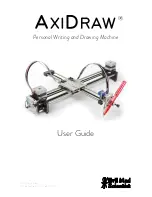
12
A
C
B
D
The examples shown above are:
A
) A certificate to be filled out (Letter size, landscape orientation)
B
) Mailing address (#10 envelope, landscape orientation)
C
) A formal invitation (6 ⅜ × 8 ⅞ inch, portrait orientation)
D
) A page of mixed text and drawing (Letter size, portrait orientation)
In every case, line up the corner of the paper with the upper left corner of the Clip Easel,
such that the corner of the paper is closest to the Home Corner.
If your document is wider than it is tall (or square), it is said to be in
landscape orientation
,
and your paper should be oriented as in examples
A
and
B
above. If is taller than it is wide,
it has
portrait orientation
; turn your paper “sideways” as in examples C) and D) above. (This
default behavior can be overridden. See “9.6 Advanced options” on page 28.)
6.3 Moving beyond the Clip Easel
While the Clip Easel is versatile, its use is entirely optional. Paper can be also held in place
with tape, clamps, tacks, other types of clipboards, and by other means as necessary.
If your AxiDraw is used as a single-purpose machine (that is, if you use the same pen
and paper size consistently), you will likely prefer to make a workholding solution tailored
for your specific application. For example, you might use multiple clip easels (or similar
boards) with endstops that hold them in place. Or perhaps standard clipboard, perma-
nently mounted to a tabletop or work surface. Dedicated solutions like these can make it
much faster to swap paper in and out for printing.
§6.2, Workholding with the Clip Easel, continued



























